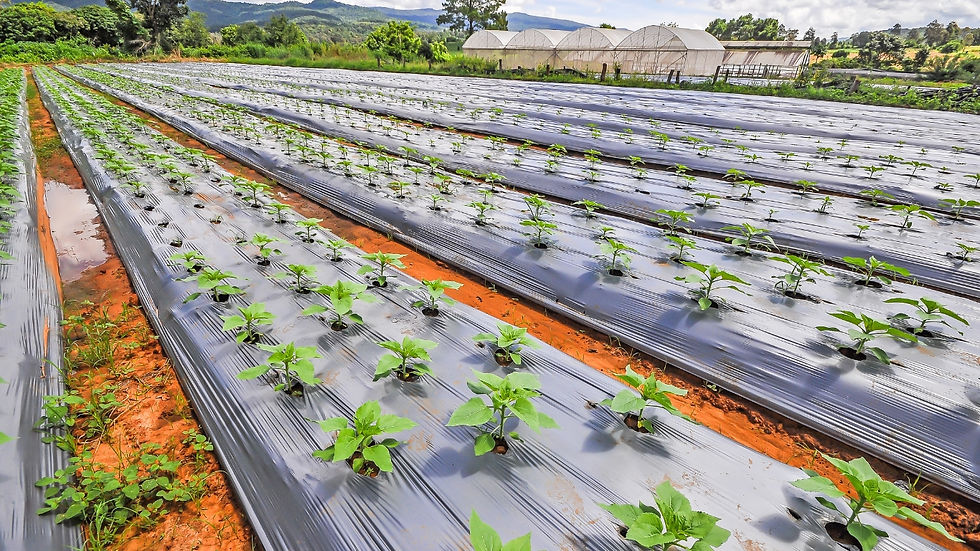Why Biodegradable Mulch Film is the Future of Eco-Friendly Farming
- mavtinstith7
- Aug 24, 2024
- 4 min read

Imagine a world where farming practices can be both highly productive and environmentally friendly. Thanks to advancements in agricultural technology, this vision is becoming a reality. One of the most innovative tools in this movement is biodegradable mulch film. Unlike traditional plastic mulch, biodegradable mulch film is made from natural substances that decompose within a year. This small change can have enormous benefits for the environment, crop yields, and our ecosystem. In this blog post, we will explore what biodegradable mulch film is, its advantages, and why it is the future of eco-friendly farming.
What is Biodegradable Mulch Film?
Biodegradable mulch film is an alternative to traditional plastic mulch used to cover and protect crops. It is made from materials such as cornstarch, sugar cane, and potato starch. These substances are converted into biomaterials that decompose into natural components like CO2, water, organic matter, and new soil. This eco-friendly product offers farmers and growers an efficient way to sustain their harvests while protecting the environment.
The Making of Biodegradable Mulch Film
The process of creating biodegradable mulch film involves converting natural substances into polymers. These polymers have the same functional properties as traditional plastics but break down naturally over time. Cornstarch, sugar cane, and potato starch are some of the primary materials used in this process. They undergo a series of chemical reactions to form biodegradable polymers, which are then molded into mulch film.
How it Works
Once laid over the soil, biodegradable mulch film starts to work immediately. It acts as a barrier against weeds, retains soil moisture, and regulates soil temperature. Over time, the film gradually decomposes, leaving no harmful residues behind. This natural degradation process makes biodegradable mulch film an excellent choice for sustainable farming.
Comparison with Traditional Plastic Mulch
Traditional plastic mulch may offer similar benefits in terms of soil temperature regulation and weed control, but it comes at a high environmental cost. Made from polyethylene, traditional mulch takes hundreds of years to decompose. It accumulates in the soil, causing long-term pollution and damage to both land and water ecosystems. In contrast, biodegradable mulch film decomposes within a year, leaving the soil healthy and free from pollutants.
Benefits of Using Biodegradable Mulch Film
Environmental Impact
One of the most significant advantages of biodegradable mulch film is its positive impact on the environment. Unlike plastic mulch, which contributes to plastic waste and pollution, biodegradable mulch film decomposes naturally. This helps reduce plastic waste, protect natural resources, and decrease carbon emissions. By preventing waste accumulation and soil pollution, biodegradable mulch film ensures that our land remains fertile for future generations.
Improved Crop Yields
Biodegradable mulch film offers numerous benefits to crop production. It controls soil temperature and moisture, inhibits weed growth, and protects crops from pests and pathogens. The balanced soil temperature and moisture levels create a healthier growing environment, promoting root growth and fruit and vegetable production. This results in higher crop yields and a longer growing season, allowing farmers to sell more produce and increase their profits.
Economic Advantages
Using biodegradable mulch film can also provide economic benefits for farmers. Although it may have a higher upfront cost compared to traditional plastic mulch, the long-term savings are substantial. Farmers save money on labor and disposal costs associated with removing plastic mulch. Additionally, the increased crop yields and extended growing season translate to higher revenues, making biodegradable mulch film a cost-effective solution.
Soil Health
Healthy soil is essential for sustainable farming. Biodegradable mulch film helps maintain soil health by preventing erosion and promoting the growth of beneficial microorganisms. As the film decomposes, it enriches the soil with organic matter, improving its structure and fertility. This leads to healthier crops and more robust yields over time.
How to Use Biodegradable Mulch Film
Preparing the Soil
Before laying biodegradable mulch film, it is crucial to prepare the soil properly. This involves tilling the soil to remove any debris and ensure a smooth surface. Proper soil preparation helps the mulch film adhere better and enhances its effectiveness in controlling weeds and retaining moisture.
Laying the Mulch Film
Once the soil is prepared, the biodegradable mulch film can be laid over the planting area. It is essential to secure the edges of the film to prevent it from shifting or blowing away. This can be done using soil, stones, or biodegradable stakes. Ensuring that the film is taut and evenly spread will maximize its benefits.
Planting Crops
After the mulch film is in place, you can create holes or slits for planting crops. It is essential to ensure that the holes are large enough to accommodate the plants without damaging their roots. Planting through the mulch film helps retain soil moisture, reduce weed competition, and protect young plants from pests.
Maintenance and Monitoring
Regular monitoring is essential to ensure that the biodegradable mulch film is functioning correctly. Check for any signs of damage or wear and tear, and make repairs if necessary. As the film decomposes, it will gradually break down and integrate into the soil, leaving no harmful residues behind.











コメント